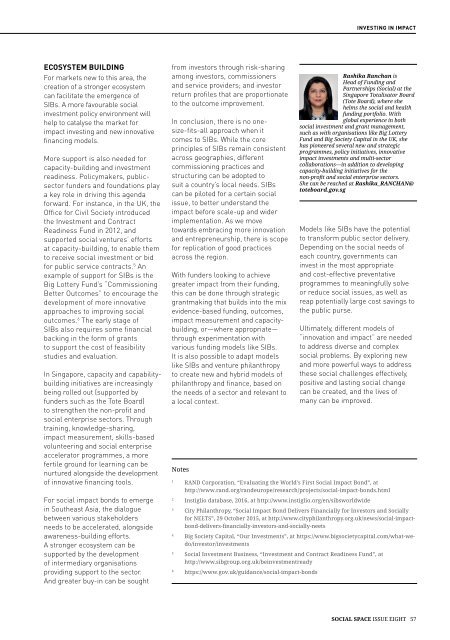Social Space (Issue 8, 2016-2017) - The Social Finance Issue
Since its debut in 2008, Social Space, the bi-annual flagship publication of the Lien Centre for Social Innovation at Singapore Management University, has provided a platform for local and international practitioners and thought leaders to share their perspectives on social innovation and entrepreneurship. Available in print and online (http://www.socialspacemag.org).
Since its debut in 2008, Social Space, the bi-annual flagship publication of the Lien Centre for Social Innovation at Singapore Management University, has provided a platform for local and international practitioners and thought leaders to share their perspectives on social innovation and entrepreneurship. Available in print and online (http://www.socialspacemag.org).
Create successful ePaper yourself
Turn your PDF publications into a flip-book with our unique Google optimized e-Paper software.
INVESTING IN IMPACT<br />
Ecosystem Building<br />
For markets new to this area, the<br />
creation of a stronger ecosystem<br />
can facilitate the emergence of<br />
SIBs. A more favourable social<br />
investment policy environment will<br />
help to catalyse the market for<br />
impact investing and new innovative<br />
financing models.<br />
More support is also needed for<br />
capacity-building and investment<br />
readiness. Policymakers, publicsector<br />
funders and foundations play<br />
a key role in driving this agenda<br />
forward. For instance, in the UK, the<br />
Office for Civil Society introduced<br />
the Investment and Contract<br />
Readiness Fund in 2012, and<br />
supported social ventures’ efforts<br />
at capacity-building, to enable them<br />
to receive social investment or bid<br />
for public service contracts. 5 An<br />
example of support for SIBs is the<br />
Big Lottery Fund’s “Commissioning<br />
Better Outcomes” to encourage the<br />
development of more innovative<br />
approaches to improving social<br />
outcomes. 6 <strong>The</strong> early stage of<br />
SIBs also requires some financial<br />
backing in the form of grants<br />
to support the cost of feasibility<br />
studies and evaluation.<br />
In Singapore, capacity and capabilitybuilding<br />
initiatives are increasingly<br />
being rolled out (supported by<br />
funders such as the Tote Board)<br />
to strengthen the non-profit and<br />
social enterprise sectors. Through<br />
training, knowledge-sharing,<br />
impact measurement, skills-based<br />
volunteering and social enterprise<br />
accelerator programmes, a more<br />
fertile ground for learning can be<br />
nurtured alongside the development<br />
of innovative financing tools.<br />
For social impact bonds to emerge<br />
in Southeast Asia, the dialogue<br />
between various stakeholders<br />
needs to be accelerated, alongside<br />
awareness-building efforts.<br />
A stronger ecosystem can be<br />
supported by the development<br />
of intermediary organisations<br />
providing support to the sector.<br />
And greater buy-in can be sought<br />
from investors through risk-sharing<br />
among investors, commissioners<br />
and service providers; and investor<br />
return profiles that are proportionate<br />
to the outcome improvement.<br />
In conclusion, there is no onesize-fits-all<br />
approach when it<br />
comes to SIBs. While the core<br />
principles of SIBs remain consistent<br />
across geographies, different<br />
commissioning practices and<br />
structuring can be adopted to<br />
suit a country’s local needs. SIBs<br />
can be piloted for a certain social<br />
issue, to better understand the<br />
impact before scale-up and wider<br />
implementation. As we move<br />
towards embracing more innovation<br />
and entrepreneurship, there is scope<br />
for replication of good practices<br />
across the region.<br />
With funders looking to achieve<br />
greater impact from their funding,<br />
this can be done through strategic<br />
grantmaking that builds into the mix<br />
evidence-based funding, outcomes,<br />
impact measurement and capacitybuilding,<br />
or—where appropriate—<br />
through experimentation with<br />
various funding models like SIBs.<br />
It is also possible to adapt models<br />
like SIBs and venture philanthropy<br />
to create new and hybrid models of<br />
philanthropy and finance, based on<br />
the needs of a sector and relevant to<br />
a local context.<br />
Notes<br />
Rashika Ranchan is<br />
Head of Funding and<br />
Partnerships (<strong>Social</strong>) at the<br />
Singapore Totalisator Board<br />
(Tote Board), where she<br />
helms the social and health<br />
funding portfolio. With<br />
global experience in both<br />
social investment and grant management,<br />
such as with organisations like Big Lottery<br />
Fund and Big Society Capital in the UK, she<br />
has pioneered several new and strategic<br />
programmes, policy initiatives, innovative<br />
impact investments and multi-sector<br />
collaborations—in addition to developing<br />
capacity-building initiatives for the<br />
non-profit and social enterprise sectors.<br />
She can be reached at Rashika_RANCHAN@<br />
toteboard.gov.sg<br />
Models like SIBs have the potential<br />
to transform public sector delivery.<br />
Depending on the social needs of<br />
each country, governments can<br />
invest in the most appropriate<br />
and cost-effective preventative<br />
programmes to meaningfully solve<br />
or reduce social issues, as well as<br />
reap potentially large cost savings to<br />
the public purse.<br />
Ultimately, different models of<br />
“innovation and impact” are needed<br />
to address diverse and complex<br />
social problems. By exploring new<br />
and more powerful ways to address<br />
these social challenges effectively,<br />
positive and lasting social change<br />
can be created, and the lives of<br />
many can be improved.<br />
1<br />
RAND Corporation, “Evaluating the World's First <strong>Social</strong> Impact Bond”, at<br />
http://www.rand.org/randeurope/research/projects/social-impact-bonds.html<br />
2<br />
Instiglio database, <strong>2016</strong>, at http://www.instiglio.org/en/sibsworldwide<br />
3<br />
City Philanthropy, “<strong>Social</strong> Impact Bond Delivers Financially for Investors and <strong>Social</strong>ly<br />
for NEETS”, 29 October 2015, at http://www.cityphilanthropy.org.uk/news/social-impactbond-delivers-financially-investors-and-socially-neets<br />
4<br />
Big Society Capital, “Our Investments”, at https://www.bigsocietycapital.com/what-wedo/investor/investments<br />
5<br />
<strong>Social</strong> Investment Business, “Investment and Contract Readiness Fund”, at<br />
http://www.sibgroup.org.uk/beinvestmentready<br />
6<br />
https://www.gov.uk/guidance/social-impact-bonds<br />
<strong>Social</strong> <strong>Space</strong> ISSUE EIGHT 57


